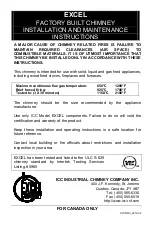
WWW.BALTIMOREAIRCOIL.COM
25
Cold Weather Operation
Inspection & Maintenance
Fan Section Icing Protection
Temperature Setting
Fan Control
Basin Water and Internal Piping
Freeze Protection
Cold Water Basin Protection
Temperature Setting
Low leaving fluid temperatures promote ice formation. During operation in subfreezing
ambient temperatures, maintain the leaving water temperature as high as possible. Ensure
the unit operates with the maximum possible heat load. The recommended minimum
process fluid temperature is 42°F (5.5°C).
Fan Control
Reduce the unit capacity by cycling the fan(s), thus modulating the airflow through the
unit. Rapid on-off cycles can cause the fan motor to overheat. Set the controls to allow
a maximum of six on-off cycles per hour. Periodically, cycle the fan(s) off to prevent ice
formation and/or to melt ice that accumulates on the combined inlet shields.
The following are fan control methods:
•
Variable Frequency Drives
: VFDs offer the most precise method of capacity control by
modulating fan motor speed. When using VFDs, avoid operating at or near resonant
speeds. Units with VFDs require premium efficient/inverter duty motors. See
page 30
for more information.
•
Fan Cycling
: Cycle the fan off for five minutes every 15 to 20 minutes for each cell. If
ice continues to build on the air intake, decrease the on-time. Observe the
air intake of
the unit at least every four to eight hours.
•
Fan Reversal:
This procedure should be used only after the other methods of fan
control fail. If utilized, the fan(s) should be run in reverse for no longer than 20
minutes at no more than 50% speed and the unit should be observed during this time.
Before returning to normal operation, visually inspect the fan blades for ice formation
Basin Water and Internal Piping Freeze Protection
Cold Water Basin Protection
It is important to protect the basin and internal piping. The basin water could freeze when
the unit is shutdown and exposed to subfreezing ambient temperatures.
•
Remote Sump
: The ideal method of protection is a remote sump located in a heated
indoor space. When the circulating pump stops, the water in the connecting piping
will drain by gravity to this indoor sump.
•
Basin Heaters
: On applications without a remote sump, heat must be provided to
the cold water basin. Electrical immersion heaters can provide the required function.
Contact your local BAC Representative for details.
•
Electric Water Level Control
: An electric water level control will maintain the proper
water level regardless of the thermal load or variations in make-up water supply
pressure. The two-position, slow closing solenoid valve provided with the BAC electric
water level control package also minimizes valve freezing problems (see
page 17
).
•
Heat Tracing
: Heat trace and insulate all exposed water piping including system piping
below the overflow level and make-up water lines with electrical heater tape.
NOTE:
Modulating the water
flow rate to the unit is NOT a
recommended method of controlling
cooling capacity.
NOTE:
For remote sump
applications, the water level in
the basin of the equipment is a
function of the design flow rate,
the quantity, size and location
of the remote sump connection
and the pipe design between the
cooling tower and the remote sump.
Units installed on remote sump
applications are supplied without a
make-up connection.










































